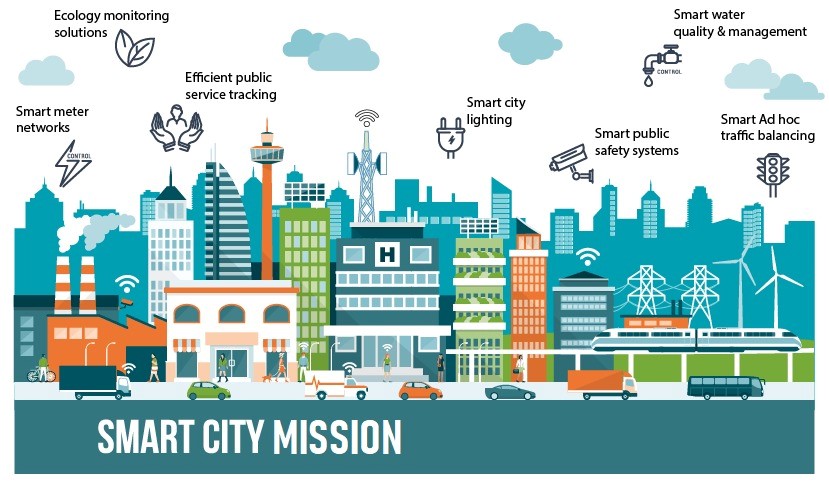Smart City Mission
January 27, 2025 2025-01-27 9:34Smart City Mission

Smart City Mission
By: Guradeeshwar Singh Rangi
I Abstract:
India launched the Smart City Mission (SCM) in June 2015 with the vision of making 100 cities smart by 2030. This project is implemented by the Ministry of Housing and Urban Affairs—posting sustainable urbanization which combines digital technology to develop infrastructure, governance, and life-organization in cities. The mission focuses on e-governance, water and waste management systems, and transportation systems betterment. While, economic problems have made a greater headway in states like Tamil Nadu and Uttar Pradesh, issues like low funding across all research projects, lack of awareness among the public, coordination between agencies at state & Central Government levels continue to be challenges. SCM is one of the important schemes to handle urbanisation at a rapid pace and make it sustainable.
II Background:
Launched in 2015, the Smart City Mission (SCM) of the Government of India is a step towards transforming urban life through modern technologies, practices and governance. . The mission addresses the complex challenges posed by concentrating on area-based development encompassing retrofitting, redevelopment, and greenfield projects and pan-city solutions that employ data and technology to modernise infrastructure.
Special Purpose Vehicles (SPVs) are the entities created as part of the SCM to design, fund, and execute projects for cities. These SPVs, created through collaborative efforts between state governments and urban local bodies, are a key feature of the mission. The SCM also focuses on public-private partnerships (PPPs) and is harmonised with other Government schemes. This brings in the complementing missions, such as that of AMRUT and the Swachh Bharat Mission to justify a holistic approach to Urban Development.
At ₹48,000 crore, the SCM provides and enables cities to implement varied projects based on their local needs. Some of the key initiatives included the Environmental Sustainability Efforts/ Greenfield Projects in Indore, Public Transport System enhancement in Surat, Smart Waste Management and Digital Governance through citizen services in Pune, Rejuvenation of Water Bodies in Coimbatore and an Urban Core Re-development with a focus on tourism end use integration at Srinagar.
By emphasizing technology-based governance, SCM is ushering in sustainable economic development while drastically improving critical services and urban mobility throughout India. The mission is essential to help realise the vision of smart, inclusive and sustainable cities which will enhance the quality of life for millions living in urban areas.
III Key Components and Features:
Smart Cities include a whole bunch of elements designed to make urban life better through technology and sustainability. The elements feature Smart Buildings, which focus on providing robust ICT infrastructure, high-quality and energy-efficient housing, and affordable options for lower-income residents. Smart Environment focuses on pollution control, environmental monitoring and sustainable resource management by using wireless communication technologies (Hoque & Prakash, 2023).
Smart Energy projects focus on renewable energy like solar, smart grids and electric metering, and sustainable waste management to ensure sufficient sustaining bill electricity supply. Public safety, healthcare, education and digital communication via Smart Public Services and IT Communication also include the ability to make use of smart traffic control systems and disaster management (Hoque & Prakash 2023).
Smart Transportation emphasises sustainable and secure transit systems, adoption of electric and CNG vehicles as well as enhancement of walkability & cycling infrastructure. Finally, Smart Governance highlights the role of e-governance, transparency, accountability and citizen participation with the provision of digital services such as online certificates, payment of utility bills, e-procurement etc. Wider roadways, street lights with sensors, eco-friendly city parks, and underground utility remark those streets all these additional attributes making the urban people-centred inclusive smart cities (Hoque & Prakash, 2023).
IV Key Issues:
Abstract: There are some major challenges faced by Smart City Mission that hamper its effectiveness and growth. First among issues is the financial limitation from inevitable funding bounds and an overdependence on public-private partnerships (PPPs), which restricts timely project delivery (Accountability Initiative, 2023). However, poor engagement with local citizens has resulted in public discontent in cities like Dholera (Prasad and Alizadeh 2020) highlighting the need for improved citizen engagement within such projects. In addition, the mission’s strong focus on techno-economic fixes overlooks basic infrastructure gaps and contributes to exclusion and inaccessibility for poorer segments of households (Moik et al., 2021).
These challenges are related to the coordinated nature of multi-level governance and the diverse capacities of Special Purpose Vehicles (SPVs), which lead to administrative complexities, sluggishness in project implementation and loss of efficiency (Javed & Khan, 2020.) There is also a heavy presence of environmental problems as greenfield developments preserve large amounts of land and can result in detrimental effects to biodiversity (Randhawa & Kumar, 2017) In addition, ambiguous dissemination and monitoring structures result in uneven implementation across cities which dilutes the overall aims of the missions(Aijaz & Hoelscher, 2015).
V Policy Recommendations:
- Context-Sensitive Definition of ”Smart” Solutions: Allow cities to create context-sensitive definitions, and assess smart solutions that change priorities based on evidence It allows for cities to construct interventions responsive to local social, economic and environmental problems for enhanced impact and inclusiveness.
- Step Change in Financial Structuring via Layered Financing Models: shift to a layered funding model that marries government funding, public-private partnerships (PPPs), and municipal bonds étape Change in Financial Structuring via Layered Financing Models: promote a multi-tiered financing approach which integrates government funds, public-private partnerships (PPPs), and [13]municipal bonds. Such diversification can help lessen the central allocation or public-private partnership monopoly, encourage fiscal discipline, and draw private investment into a more sound framework for urban growth.
- Incorporating Participatory Governance in SPVs: Introduce citizen participation measures into Special Purpose Vehicles (SVPs), for example, by establishing advisory committees or stakeholder panels that enhance accountability and transparency and ensure alignment with community priorities. We need a whole-community structured participation that builds trust and makes sure the decisions reflect the community’s real needs.
- Governance with Data-Driven Command Systems: Create an integrated data governance framework across the cities that also embeds advanced analytics and actionability in command centres in real-time. Such infrastructure would increase the capacity for urban servicing, improve inter-agency coordination and predictive planning, and equip cities with cleaner pathways towards resilient and sustainable growth.
VI Conclusion:
From this experience comes the Smart Cities Mission: a cross-cutting policy that approaches oven development in India by embracing technology, sustainability and participatory governance to address unique urban challenges. The mission should focus on context-specific solutions, broaden financing models and embed citizen engagement within Special Purpose Vehicles (SVPs) to achieve its purpose. Providing data-driven governance frameworks and strengthening inter-agency coordination is essential to ensure urban growth that is sustainable and resilient. Improving on these aspects, the mission can better deliver to local needs, making smart cities more inclusive, functional and enabling them to provide sustainable economic and social benefits across urban areas of India.
References:
- Aijaz, R., & Hoelscher, K. (2015). India’s Smart Cities Mission: An Assessment.
- Jawaid, M. F., & Khan, A. R. (2020). The Smart City Mission in India and Prospects of Improvement in the Urban Environment. IOP Conference Series: Materials Science and Engineering, 955(1). https://doi.org/10.1088/1757-899X/955/1/012001
- Kumar, A., & Randhawa, A. (2017). Exploring Livability as a Dimension of Smart City Mission (India). International Research Journal of Engineering and Technology. https://www.researchgate.net/publication/342259834
- Moik, B., Bobek, V., & Horvat, T. (2021). India’s National Smart City Mission: Analysis of Project Dimensions Including Sources of Funding. Mednarodno Inovativno Poslovanje = Journal of Innovative Business and Management, 13(1), 50–59. https://doi.org/10.32015/jibm/2021.13.1.50-59
- Prasad, D., & Alizadeh, T. (2020). What Makes Indian Cities Smart? A Policy Analysis of Smart Cities Mission. Telematics and Informatics, 55. https://doi.org/10.1016/j.tele.2020.101466
- Summary & Analysis Highlights. https://www.indiabudget.gov.in/.
- WEF_Smart_Cities_Promoting_Urban_Governance_in_India_2023.






